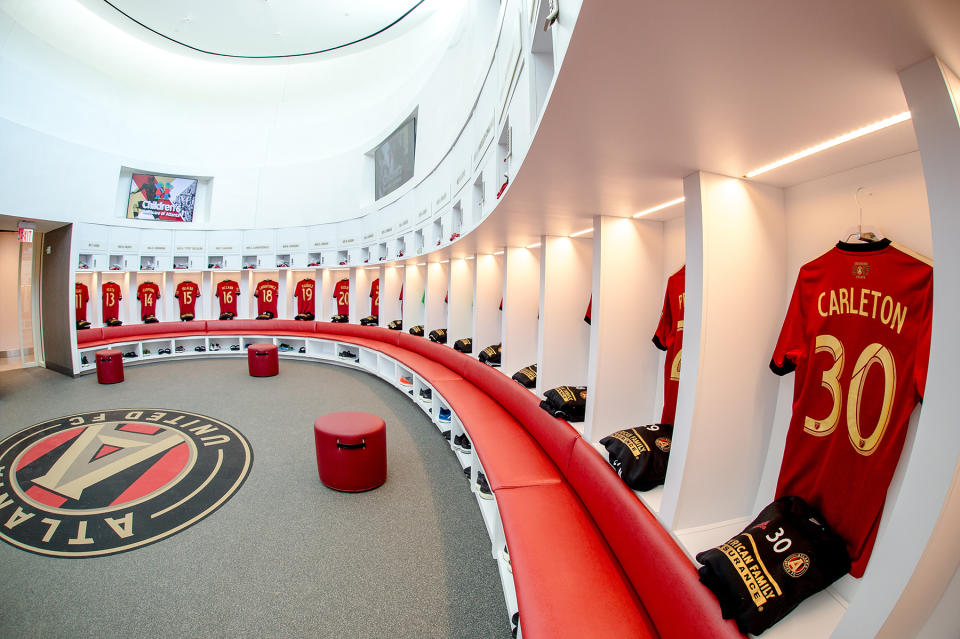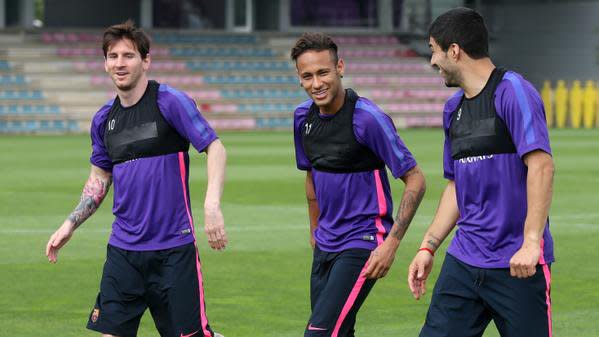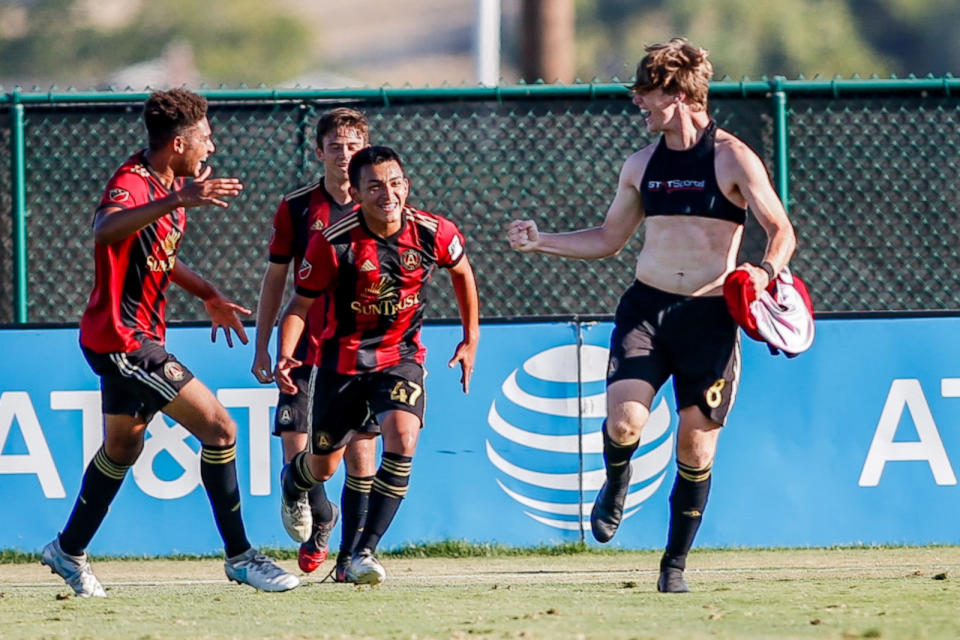How US Soccer develops the superstars of tomorrow using tech
At Atlanta United, GPS devices are giving training a new meaning.
Evangelo Spartiatis, 18, still remembers seeing professional soccer players on Facebook and Instagram wearing "some vest" during training. "What is that?" he recalls thinking. "Why are they wearing it?" Well, as it turns out, what was once a curiosity for him three years ago is, now, something he's all too familiar with. That "vest" Spartiatis talks about is part of a GPS-tracking system he has to wear every day he trains at the Atlanta United Academy, where he plays for the Under-19 development team of the current Major League Soccer (MLS) champion. He's one of Atlanta United's 155 youth players training with the Apex GPS, a wearable designed to measure their distance covered, acceleration, deceleration, speed and work rate.
Developed by STATSports, a company founded in 2008 in Northern Ireland, the Apex Athlete Monitoring system consists of a vest that goes between a player's shoulder blades and a small, lightweight GPS device that attaches to it. During a typical training session, its system will collect millions of data points from players, which, STATSports says, can be streamed to a laptop, smartphone, tablet or smartwatch in real time. This allows coaches and training staff to monitor a player's performance live, both in training or in an actual match. If a player isn't covering ground they're supposed to, or if they're not running as fast as they could, the team's staff will know immediately.
Atlanta United's use of the Apex Athlete Monitoring system is part of a deal between STATSports and US Soccer announced in March of 2018 as the "world's largest-ever wearable performance tracking device partnership." Together, they brought more than 6,500 Apex GPS units to professional players for the men and women teams of US Soccer, as well as the organization's 74 development academies. The goal with the latter, US Soccer and STATSports said, is to benefit youth soccer at the grassroots level, where data produced by the Apex Athlete Monitoring system could help shape the stars of the future. At the very least, it can determine who is committed and who isn't.
At the development stage, young players need all the help they can get to make it to the next level, and coaches at Atlanta United are using data from the Apex GPS to push and accelerate the development of prospect players -- those who have a real shot at playing in the senior MLS squad. Just four weeks ago, Atlanta United sold Miguel Almiron, one of its young stars, for a reported fee of $27 million to English Premier League club Newcastle United. And while Almiron wasn't a homegrown player, it shows you the business potential of proper youth development.

In December 2016, three months before Atlanta United had even made its MLS debut, Tony Annan took the role of the team's Academy Director. While the club was founded in 2014, Atlanta United didn't actually play its first MLS match until March 5th, 2017, but by then its development academy was already in full force. Annan told Engadget that his job is to ensure he gets youth players, all the way from 12 to 19 years old, ready for Atlanta United's professional team. His role entails anything from planning training sessions and communicating with other coaches to dealing with parents who want to check on the progress of their kids.
Right now, there are 12 prospects across three to four age groups at the Atlanta United Academy, all of whom are going through individual development work to help them take the next step in their soccer career. Annan says this means using data and metrics from the Apex Athlete Monitoring systems to know what players are doing right or wrong, and to know how much they can be pushed to their limit. "A lot of technology these days is used to push players," he said, "but we can use it to pull back, as well." Pulling back, he added, is essential to avoid injuries, which can be crucial early on in a player's development.
"You call them gamers. They don't train very well, they don't look interested, their numbers are rubbish, and then they come to a game and they light it up."
As much as it helps to get an unprecedented amount of insight into an individual's performance, though, there are players whose data points may not be particularly positive. But they stand out in a different way: These are players who have the intangibles needed to succeed in soccer, that magic touch. They're players who maybe don't run half as hard as everyone else in training, and who would be flagged by the Apex GPS devices as underperforming, but that during a match they'll do better than their entire team.
"You call them gamers," Annan said. "They don't train very well, they don't look interested, their numbers are rubbish, and then they come to a game and they light it up." He added that these are anomalies in football, where a player does whatever they want in training and, yet, the game seems to come easily to them. "They don't really put forth an effort, and all of a sudden they win you the game," said Annan. "As a coach, you've got to respect that. You've got to leave it alone, 'cause if you start messing with that and start fiddling about with that player, you can actually put them the other way."
In cases like that, the best you can do with the data from the Apex Athlete Monitoring system is use it to encourage those special players to work harder. "The idea is to try and teach kids how to train, so using the [data] to show them how little they work is useful," Annan said. "Even if they light it up in games, there's still got to be some accountability to how hard they work as youth players because when they make that step to a professional level, they won't be able to get away with it. Unless they're very, very, very special."

To better understand the work being done by STATSports, US Soccer and Atlanta United, you have to go back to October 9th, 2015. That's when soccer's governing body, FIFA (Fédération Internationale de Football Association), and IFAB (International Football Association Board) officially approved the use of wearable technology in the sport. That same day, IFAB, the organization responsible for writing and approving the rules of soccer, invited companies to FIFA's headquarters in Zurich, Switzerland, to learn more about how these fitness trackers worked.
Since then, FIFA and IFAB have been working to create a global standard for what they call Electronic Performance Tracking Systems (EPTS), such as STATSports' Apex GPS wearable devices. EPTS also includes local positioning and camera systems, which use video to capture fitness data from players on the field.

Before these can be used by professional teams, IFAB has certain requirements that need to be met for certification. According to the Laws of the Game 17/18, which were updated on June 1st, 2018, to include EPTS, these tracking technologies "must not be dangerous" and "information and data transmitted from the devices/systems is not permitted to be received or used in the technical area during the match." The latter requirement is subjective, however, meaning it's up to competition organizers (like the MLS) to decide whether or not they want to allow teams to use wearable tracking systems in a game, not just in training.
While EPTS are primarily intended to track player and ball positions, IFAB has also approved them to be used in tandem with sensors like accelerometers and gyroscopes, as well as heart-rate monitors. Atlanta United players, for instance, wear a black strap underneath their Apex Athlete Monitoring vests with an embedded heart-rate sensor. But that device isn't made by STATSports; it's from a US-based company called Polar. Ultimately, it's up to each club and its coaching staff to choose the system that best fits its needs.
Along with STATSports, there are five other companies licensed by FIFA to produce EPTS wearables. Among them is Catapult Sports, whose technology is used by over 2,000 teams, including major soccer clubs like Chelsea, Bayern Munich and the Dallas Mavericks and Pittsburgh Steelers in the NBA and NFL, respectively. Meanwhile, STATSports' Apex Athlete Monitoring systems are used by Arsenal, Liverpool, Manchester United, Manchester City, FC Barcelona, Juventus and, outside soccer, the NBA's Washington Wizards, among others.
"It's a great, great tool, but it still is a tool, and it still requires other aspects of performance, other aspects of coaching and other aspects of medicine to be layered in on that decision-making process."
For US Soccer, using STATSports' system is about ensuring there's a data set standard for club and national teams to follow. The partnership means youth academies in the US get free Apex GPS units, but it's also about educating coaches and helping them understand the data that's going to available to them. James Bunce, High Performance Director at US Soccer, said there's no value in data without context, so his job is to make sure that clubs and coaches in the country are on the same page.
He said wearable GPS devices are "a massive step in science in the last ten years" because previously all coaches could rely on was using either heart-rate sensors or their eyes only. "Now you get to the point we can measure this internal and external load from this device and at a high accuracy," said Bunce. "It's a great, great tool, but it still is a tool, and it still requires other aspects of performance, other aspects of coaching and other aspects of medicine to be layered in on that decision-making process."
Having a standard in place will allow for easier player-data management, too. Say a youth player from Atlanta United goes to a US Soccer training camp for a few weeks, there won't be a gap in their progress sheet because everything they did with the national team can be transferred to their club's records. Atlanta United's coaching staff will know everything they did while they were away, from how fast (or slow) they ran to how much distance they covered on the pitch in training or during a match. And if a player transfers to another MLS team, they're allowed to take their own data with them.
Technically, this could also apply to a scenario in which a player makes a move to a European club. But that would depend on whether the new team uses STATSports' hardware and software technology and, most importantly perhaps, whether there's approval from the coaching and medical staffs of the teams involved. At the moment, it's not set in stone who owns the data collected from EPTS wearable and video systems. And that's something FIFA and IFAB are going to have to figure out soon, especially as the topic of data privacy becomes increasingly important in today's society.

Like his fellow Atlanta United Academy-member, Spartiatis, Samy Kolby, 14, says he too often looks at pictures of players like FC Barcelona's Lionel Messi on social media. In them, the man who is arguably the best soccer player in the world can sometimes be seen wearing the same black vest in training that, years ago, was unfamiliar. But in 2019, the two of them can't start kicking the ball in training before putting on a GPS-equipped wearable. That's just part of life for them now as they aspire to become professional soccer players, and the same goes for the 153 others in the Atlanta United youth system and the more than 6,000 players in US Soccer development academies.
Kolby's one complaint is that the heart-rate monitor strap, which isn't part of STATSports' Apex Athlete Monitoring system, tends to be "a little bit uncomfortable." Caroline Kelly, STATSports head of US Soccer operations and sport performance, said STATSports is solely a GPS company and that making heart-rate sensors to work well with its Apex devices isn't in its foreseeable plans. "It's always something that's in the back of the mind," she said, "but it's not something we're focused on right now." Still, she added, "I would never say never."
"You know you can't slack off in training because the numbers are gonna show it."
Spartiatis echoed Kolby's concerns, saying that the Apex GPS vest (which feels like spandex and weighs only about 45 grams) is never an issue. It's just the Polar heart-rate monitor that, at times, can get tedious to wear when he plays and trains. The players said they like comparing data with their team members, and they use it to have friendly competitions between them. When coaches share with the players the fitness data they collect, which happens about once a month, the team can see who worked the hardest, ran the fastest or covered the most distance on any given day.
"It motivates you to make sure you're working hard, covering ground and making sure you're getting where you need to be," Kolby said. "Even if you come in you've had a bad day or you're tired from the training session before," Spartiatis added, "you know you can't slack off in training because the numbers are gonna show it." The data from STATSports may be good for motivating players to perform at their absolute best, but the unexpected advocates of Apex technology are the Messis of the world -- the players who Spartiatis and Kolby aspire to be in the future.
"It's a good thing 'cause you always see the pros wearing it," Kolby said. "It's a cool feeling to wear it."











